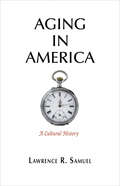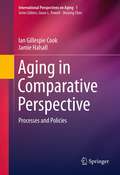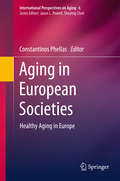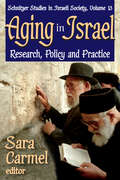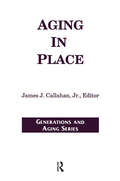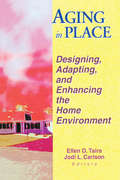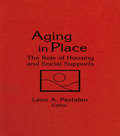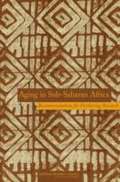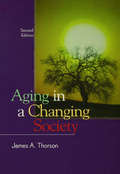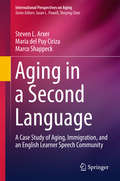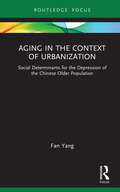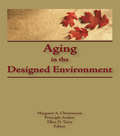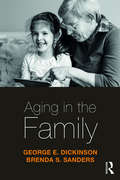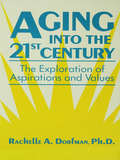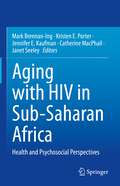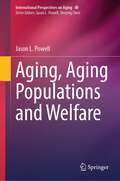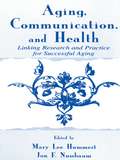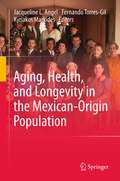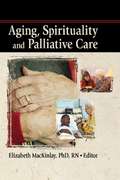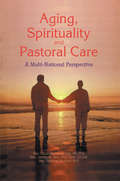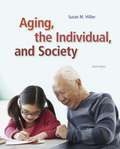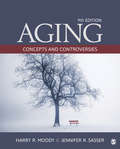- Table View
- List View
Aging in America: A Cultural History
by Lawrence R. SamuelAging is a preoccupation shared by beauty bloggers, serious journalists, scientists, doctors, celebrities—arguably all of adult America, given the pervasiveness of the crusade against it in popular culture and the media. We take our youth-oriented culture as a given but, as Lawrence R. Samuel argues, this was not always the case. Old age was revered in early America, in part because it was so rare. Indeed, it was not until the 1960s, according to Samuel, that the story of aging in America became the one we are most familiar with today: aging is a disease that science will one day cure, and in the meantime, signs of aging should be prevented, masked, and treated as a source of shame.By tracing the story of aging in the United States over the course of the last half century, Samuel vividly demonstrates the ways in which getting older tangibly contradicts the prevailing social values and attitudes of our youth-obsessed culture. As a result, tens of millions of adults approaching their sixties and seventies in this decade do not know how to age, as they were never prepared to do so.Despite recent trends that suggest a more positive outlook, getting old is still viewed in terms of physical and cognitive decline, resulting in discrimination in the workplace and marginalization in social life. Samuels concludes Aging in America by exhorting his fellow baby boomers to use their economic clout and sheer numbers to change the narrative of aging in America.
Aging in Asia: Findings from New and Emerging Data Initiatives
by James P. SmithThe population of Asia is growing both larger and older. Demographically the most important continent on the world, Asia's population, currently estimated to be 4.2 billion, is expected to increase to about 5.9 billion by 2050. Rapid declines in fertility, together with rising life expectancy, are altering the age structure of the population so that in 2050, for the first time in history, there will be roughly as many people in Asia over the age of 65 as under the age of 15. It is against this backdrop that the Division of Behavioral and Social Research at the U.S. National Institute on Aging (NIA) asked the National Research Council (NRC), through the Committee on Population, to undertake a project on advancing behavioral and social research on aging in Asia. Aging in Asia: Findings from New and Emerging Data Initiatives is a peer-reviewed collection of papers from China, India, Indonesia, Japan, and Thailand that were presented at two conferences organized in conjunction with the Chinese Academy of Sciences, Indian National Science Academy, Indonesian Academy of Sciences, and Science Council of Japan; the first conference was hosted by the Chinese Academy of Social Sciences in Beijing, and the second conference was hosted by the Indian National Science Academy in New Delhi. The papers in the volume highlight the contributions from new and emerging data initiatives in the region and cover subject areas such as economic growth, labor markets, and consumption; family roles and responsibilities; and labor markets and consumption.
Aging in Comparative Perspective: Processes and Policies (International Perspectives on Aging #1)
by Jamie Halsall Ian Gillespie CookThis book examines the key aging processes in seven countries (United States, United Kingdom, Sweden, Japan, China, Nepal, and South Africa) and the main policies that have been, and are being, developed to deal with this rapid change in the demographic profile. It addresses the problems that are identified as well as the positive aspects of aging within each of these contrasting societies. Thus it makes a significant contribution to the major debates about growing old across the globe.
Aging in European Societies: Healthy Aging in Europe (International Perspectives on Aging #6)
by Constantinos PhellasBetween longer life expectancies and declining birth rates, Europe's elder population is growing into a sizable minority with considerable impact on nations, health systems, and economies--in other words, global implications as well as local and regional ones. Those investing in the health of older adults need a double perspective: the social and clinical complexity of aging and the larger forces shaping these experiences. Aging in European Societies examines aging trends across the continent, analyzing individual and collective variables that affect the lives of older adults, and drawing salient comparisons with other parts of the world. An interdisciplinary panel of experts provides theory, research, and empirical findings (with examples from the UK, Cyprus, Sweden, and others) in key areas such as family and social supports, physical and cognitive changes, dependence and autonomy issues, and living arrangements. The book's wide-net approach offers insights into not only aging, but aging well. And of particular importance, it details approaches to defining and measuring the elusive but crucial concept, quality of life. Included in the coverage: The potential for technology to improve elders' quality of life.Dementia and quality of life issues.Changes in functional ability with aging and over time.Family networks and supports in older age.Factors influencing inequalities in quality of life.Late-life learning in the E.U. Gerontologists, sociologists, health and cross-cultural psychologists, and public health policymakers will welcome Aging in European Societies as a springboard toward continued discussion, new directions for research, and improvements in policy and practice.
Aging in Hong Kong: A Comparative Perspective (International Perspectives on Aging #5)
by Jean WooWith the longest life expectancy for men and the second longest for women, Hong Kong typifies our planet's aging population. The daily lives of its older adults closely match the advantages and disadvantages experienced by urban elders in other developed countries. For these reasons, Hong Kong's elderly serve as a salient guide to older people's social, psychological, and healthcare needs--concerns of increasing importance as the world grows older. Aging in Hong Kong examines this emblematic population as a case study specifically in comparison with their counterparts in the West, shedding light on diverse, interrelated currents in the aging experience. Referencing numerous international studies, the book contrasts different health service arrangements and social factors and relates them to a variety of health outcomes. Its wide-ranging coverage documents health and illness trends, reviews age-friendly policy initiatives, relates health literacy to patients' active role in their own care, and discusses elders as an underserved group in the division of limited health funding and resources. This multiple focus draws readers' attention to policies that need revisiting or retooling as chapters analyze major life areas including: Living environment.Retirement and post-retirement employment issues.Financial asset management.Health literacy regarding aging issues.Elder-positive service delivery models.Ageism in the prioritization of healthcare.End-of-life issues. By assembling such a wealth of data on its subject, Aging in Hong Kong puts ongoing challenges into clear focus for gerontologists, sociologists, health and cross-cultural psychologists, public health policymakers, and others involved in improving the quality of elders' lives.
Aging in Israel: Research, Policy and Practice
by Sara CarmelIn the twentieth century, all developed nations began to undergo unprecedented demographic changes, as their birth rates declined, and life expectancies increased significantly --an average of thirty years in less than a century. These developments have caused major transformations in the composition of populations in these countries, especially in terms of the proportions of the various age groups. While the age groups of children and adolescents have decreased, those of elderly persons aged 65 and over, have increased.Consistent with the situation in other developed nations, the absolute number and percentage of elderly persons in the Israeli population is increasing, while the percentage of younger persons is decreasing. Israel, however, differs from other developed countries in the pace of this demographic change, the composition of its population, and the ways it can address needs related to aging. The demographic figures in Israel indicate that not only is the proportion of elderly persons in the total population growing, but that the old population itself is rapidly aging as well.This volume exemplifies how social science research can promote knowledge about and understanding of needs and opportunities for adaptation, and assist in evaluating the outcomes of policies and services on the personal, community and national levels, as well as suggest required changes. The variety of topics covered in this volume on age-related research, policies and practice reflects a wide range of research by Israeli scholars on social aspects of aging. Their research offers a glimpse into the knowledge base that has been built over the years on the aging process in Israel, the population of elderly people, and the national policies and network of services for the aged. Other developed countries with aging populations have much to learn from the Israeli experience.
Aging in Place (Generations And Aging Ser.)
by James J. Callahan"Aging in place" is among the newer terms to be included along with "senior citizen," "golden agers," and others in the lexicon of gerontology. Since aging is a lifelong process and each of us occupies three-dimensional space, we are, of course, always aging in place, but two factors have caused aging in place to emerge as a salient concern for gerontological policy makers. The first is the explosive growth of homeownership after World War II, the other is the perception that thousands of older people have been flowing into nursing homes unnecessarily when they can and should remain in their own home or apartment.
Aging in Place: Designing, Adapting, and Enhancing the Home Environment
by Jodi Carlson Ellen D TairaProvide a comfortable living environment for the aging!Aging in Place: Designing, Adapting, and Enhancing the Home Environment gives you a complete examination of current trends in adaptive home designs for older adults. As a therapist, designer, architect, builder, home planner, social worker, community organizer, or gerontologist, Aging in Place will show you innovative home designs and studies for creating environments that offer optimal living for aging adults. Complete with diagrams, floor plans, and tables, Aging in Place helps you to improve the quality of life for the elderly by offering them state-of-the-art designs that encourage independence and dignity. This unique and exciting book covers topics such as universal design which strives to create everyday environments and products like door handles and light switches that are usable by all people to the greatest extent possible, regardless of age or ability. Aging in Place will also show you how to: use follow-up visits by occupational therapists to ensure successful use of home modifications create environments that are helpful for vision rehabilitation by using controlled lighting and color schemes evaluate the quality of life for elderly people living in personal dwellings, specialized housing, and nursing homes explore architectural barriers and the uses of helping devices for elderly people examine research critiques of adaptive toilet equipment investigate modifications that have been made in homes for the elderly in India analyze ways in which elderly people have changed their homes to make the telephone more accessibleAging in Place is a complete guide to understanding the needs and latest trends in optimizing the living space of elderly persons. The book gives you access to several studies on elderly people's environmental needs and preferences in regard to modifications in personal and public dwellings. This information will assist you with better serving the elderly by helping them live more independently.
Aging in Place: The Role of Housing and Social Supports
by Leon A PastalanIn this highly practical volume, the contributing authors explore some of the dimensions associated with aging in place. There are increasing numbers of older Americans who are faced with fundamental changes in their economic circumstances, health, and marital status which have an impact on their ability to age in place. Without the necessary supports many may have no other choice but to be prematurely or inappropriately placed in costly health care facilities or be forced to move into unfamiliar, less safe, less satisfactory housing environments. Aging in Place explores some of the dimensions associated with aging in place and informs readers about unmet needs and available living options for elderly persons. Experts discuss a number of crucial factors regarding the availability of social supports and the impact it has on the independence of the elderly, specifically their living arrangements. They address the issue of control and how access to social contact and real choices about services and facilities increases independence among the elderly; congregate housing as an alternative to nursing care for those elderly too frail for less supportive housing; discharge policies concerning frailty in senior living arrangements; and the lack of a full range of services in many alleged full service communities.
Aging in Sub-Saharan Africa: Recommendation for Furthering Research
by National Research Council of the National AcademiesIn sub-Saharan Africa, older people make up a relatively small fraction of the total population and are supported primarily by family and other kinship networks. They have traditionally been viewed as repositories of information and wisdom, and are critical pillars of the community but as the HIV/AIDS pandemic destroys family systems, the elderly increasingly have to deal with the loss of their own support while absorbing the additional responsibilities of caring for their orphaned grandchildren. Aging in Sub-Saharan Africa explores ways to promote U.S. research interests and to augment the sub-Saharan governments' capacity to address the many challenges posed by population aging. Five major themes are explored in the book such as the need for a basic definition of "older person," the need for national governments to invest more in basic research and the coordination of data collection across countries, and the need for improved dialogue between local researchers and policy makers. This book makes three major recommendations: 1) the development of a research agenda 2) enhancing research opportunity and implementation and 3) the translation of research findings.
Aging in a Changing Society
by James ThorsonThe field of gerontology, the study of aging, has emerged as an area of increasing importance. This book is an introduction to the multidisciplinary field of gerontology. The text, with its friendly narrative style, assumes no prior knowledge of gerontology, sociology, or psychology.
Aging in a Changing World: Older New Zealanders and Contemporary Multiculturalism (Global Perspectives on Aging)
by Molly GeorgeThis is a story about aging in place in a world of global movement. Around the world, many older people have stayed still but have been profoundly impacted by the movement of others. Without migrating themselves, many older people now live in a far “different country” than the one of their memories. Recently, the Brexit vote and the 2016 election of Trump have re-enforced prevalent stereotypes of “the racist older person”. This book challenges simplified images of the old as racist, nostalgic and resistant to change by taking a deeper, more nuanced look at older people’s complex relationship with the diversity and multiculturalism that has grown and developed around them. Aging in a Changing World takes a look at how some older people in New Zealand have been responding to and interacting with the new multiculturalism they now encounter in their daily lives. Through their unhurried, micro, daily interactions with immigrants, they quietly emerge as agents of the very social change they are assumed to oppose.
Aging in a Second Language: A Case Study of Aging, Immigration, and an English Learner Speech Community (International Perspectives on Aging #17)
by Steven L. Arxer Maria del Puy Ciriza Marco ShappeckThis unique account of English language acquisition by Latino elders shines intimate light on the increasingly complex concerns of aging immigrant minority populations. Rich qualitative findings detail sociocultural barriers to and social and emotive factors that promote second language acquisition in older age. The book's case study highlights diverse cognitive and social processes as elders establish a sense of self as learners and as part of a learning community, and a sense of place as newcomers navigating a challenging environment. And first-person comments from the group members deftly illustrate the intricacies of being an immigrant in a rapidly changing America as well as the myriad intersections of race/ethnicity, gender, culture, and country that shape immigrant life. Included in the coverage: Minority aging in an immigrant context. Late-life second language acquisition: cognitive and psycholinguistic changes, challenges, and opportunities. Building emotions for self-identity and learning. Practicing safe language socialization in private and public spaces. Language resocialization and gender allies. Aging, second language acquisition, and health. Aging in a Second Language gives clinical social workers, gerontologists, health and cross-cultural psychologists, sociologists, educators and other professionals deep insights into the lives of an emerging active elder population. It also pinpoints challenges and opportunities in research, literacy program design, pedagogy, clinical outreach, education policy, and service delivery to immigrant elders.
Aging in the Context of Urbanization: Social Determinants for the Depression of the Chinese Older Population (China Perspectives)
by Fan YangAs China has undergone rapid urbanization and population aging in the past few decades, improving the welfare of older people in rural areas has become an ever more pressing issue. This title is the first book-length work to examine the influence of urbanization on the mental health of China’s older population outside the city. Incorporating the theoretical framework of social ecology, the author analyzes the socio-cultural factors that have exerted an impact on participants’ mental health, such as their personal life course transition, changes to family living arrangements and community restructuring. Moreover, he introduces several elderly mental health intervention models in China, while evaluating the policy initiatives that have developed based on China’s local resource sufficiency, cultural customs, and older people's needs. The research findings not only facilitate a deeper understanding of China's welfare policy making, but also offers a useful reference for countries that are experiencing similar urbanization and population aging and that wish to formulate better social policies. Students and scholars of social policy, welfare, and gerontology will find this title to be essential reading.
Aging in the Designed Environment
by Ellen D Taira Margaret ChristensonAging in the Designed Environment is the key sourcebook for physical and occupational therapists developing and implementing environmental designs for the aging. The physical environment remains one of the most overlooked areas in environmental design. In order to move beyond this status quo, persons responsible for planning elderly environments must develop a new understanding of ways in which their influence can improve the older adult’s physical and mental functioning. Occupational and physical therapists, as well as other health care professionals, will benefit tremendously from the information presented in this unique volume. Designers, developers, and others with minimal health care background will also find a wealth of possibilities within Aging in the Designed Environment. Many concerns are dealt with in the book’s five sections. The first section describes the implications that occur when there are changes in vision, hearing, taste, smell, touch, and the kinesthetic systems. Recommendations for environmental adaptation and modifications which may compensate for the changes in each of these systems are suggested. The second section stresses the relationship between behavior and environment. A variety of environmental attributes--comfort, privacy, accessibility, control, security, dignity--and their impacts are discussed, along with information on ways that attributes can be incorporated into the living settings of older people. In section three the focus is on the older person living independently in his or her own home, and section four covers exclusively the design and selection of chairs for older adults. New ways to assess and evaluate the home to promote independence beyond the traditional activities of daily living are addressed. The last section deals with redesigning the existing long-term care facility. The author examines some of the environmental conditions existing in specific facilities and provides recommendations to compensate for these circumstances.
Aging in the Family
by George E. Dickinson Brenda S. SandersWith a rapidly aging population throughout the world, the issue of larger percentages of older adults has repercussions for both policy and the job market. Whether a university student about to seek a full-time job or a caregiver for an older person, Aging in the Family should enhance the reader’s knowledge and skills. The main topics covered in this volume include marital status of older adults, support systems within families, crises with older adults within families, the resilience of older adults entering the latter stages of life, practical information involving caregiving, aging in place, and various social services for an aging population. The reader will be made aware of intergenerational interactions between older adults and other family members in various cultures. The role of ethnicity and socio-economic status in health issues of older adults will be discussed, as will the application of technology to an aging population. Though problems certainly exist as one ages, the overall thrust of the book is toward the positive aspects of growing old. Numerous theories exist to probe research and understanding of older adults in families. The relation between theory and research will be helpful to many students of aging in the family. Older adults are generally married, yet cohabitation and other options are alive and well too. Ageism, death, and abuse, unfortunately, are issues affecting aging. Yet, most older adults in the US and Western Europe report living independently and being satisfied with their lives. Aging in the Family will be an interesting read for anyone wanting to learn about older adults and family relationships, as it exhibits a blend of both theoretical and practical matters.
Aging into the 21st Century: The Exploration of Aspirations and Values
by Rachelle A. DorfmanAging Into the 21st Century draws on developmental theory and gerontological research to provide a framework for the creation of 'value-friendly' long-term care settings and for psychotherapy with the elderly.
Aging with HIV in Sub-Saharan Africa: Health and Psychosocial Perspectives
by Catherine MacPhail Janet Seeley Mark Brennan-Ing Kristen E. Porter Jennifer E. KaufmanWith the development of effective antiretroviral therapies (ART) in the mid-1990s, HIV became a treatable although serious condition, and people who are adherent to HIV medications can attain normal or near-normal life expectancies. Because of the success of ART, people 50 and older now make up a majority of people with HIV in high-income countries and other places where ART is accessible. The aging of the HIV epidemic is a global trend that is also being observed in low- and middle-income countries, including countries in sub-Saharan Africa, where the greatest number of older people with HIV reside (3.7 million). While globally over half of older adults with HIV are in sub-Saharan Africa, we have little information about the circumstances, needs, and resiliencies of this population, which limits our ability to craft effective policy and programmatic responses to aging with HIV in this region. At present, our understanding of HIV and aging is dominated by information from the U.S. and Western Europe, where the epidemiology of HIV and the infrastructure to provide social care are markedly different than in sub-Saharan Africa. Aging with HIV in Sub-Saharan Africa addresses this gap in our knowledge by providing current research and perspectives on a range of health and psychosocial topics concerning these older adults from across this region. This volume provides a unique and timely overview of growing older with HIV in a sub-Saharan African context, covering such topics as epidemiology, health and functioning, and social support, as well as policy and program implications to support those growing older with HIV. There are very few published volumes that address HIV and aging, and this is the first book to consider HIV and aging in sub-Saharan Africa. Most publications in this area focus on HIV and aging in Uganda and South Africa. This volume broadens the scope with contributions from authors working in West Africa, Botswana, and Kenya. The range of topics covered here will be useful to professionals in a range of disciplines including psychology, epidemiology, gerontology, sociology, health care, public health, and social work.
Aging, Aging Populations and Welfare (International Perspectives on Aging #40)
by Jason L. PowellAs the world experiences a rapid increase in the aging population, it is essential to address the challenges and opportunities that arise as a result. This book explores the significant impact of aging on individual well-being, societal welfare systems, and the global economy. By examining the multifaceted aspects of aging, demography and welfare, the book aims to provide a comprehensive and critical narrative to navigating these challenges and achieving better outcomes for both older individuals and society as a whole. The book has a critical approach running through it; despite this, there is a need to do something with the critical questions and focus on sustainable solutions to problems and issues an aging population poses to researchers, policy makers and older people themselves. In essence, the primary purpose of this book is to shed light on the complexities surrounding aging, demography and its intersection with welfare systems. By delving into various perspectives, such as social, economic, and healthcare considerations, this book highlights the holistic understanding needed to address the challenges associated with an aging population effectively.
Aging, Communication, and Health: Linking Research and Practice for Successful Aging (Routledge Communication Series)
by Jon F. Nussbaum Mary Lee HummertThis collection highlights the current efforts by scholars and researchers to understand the aging process as it relates to the health of older adults. With contributions from international scholars in communication, psychology, public health, medicine, nursing, and other areas, this volume emphasizes communication as a critical research, education, policy, and practice issue for the design, provision, and evaluation of health and social services for older adults. Organized into sections addressing communication developments in the healthcare arena, issues in provider-patient communication, and the relationships between family communication and health. The chapters cover critical topics related to successful aging, such as Alzheimer's disease, managed care and older adults, communication issues of severe dementia, and healthcare decision-making within families. The editors have designed this volume to be accessible to a broad audience, including scholars and students of aging and communication, healthcare practitioners with older clients, and aging individuals and their families who are pursuing strategies for successful aging. The chapters represent the highest levels of current scholarship on communication, aging, and health, providing a strong foundation for future research. Each contribution also addresses the applied implications of this research, offering practical guidance to readers dealing with these issues in their own lives. As a whole, Aging, Communication, and Health represents a major advance toward understanding the importance and application of communication for successful aging.
Aging, Health, and Longevity in the Mexican-Origin Population (Social Disparities In Health And Health Care Ser.)
by Jacqueline L. Angel Fernando Torres-Gil Kyriakos MarkidesAging, Health, and Longevity in the Mexican-Origin Population creates a foundation for an interdisciplinary discussion of the trajectory of disability and long-term care for older people of Mexican-origin from a bi-national perspective. Although the literature on Latino elders in the United States is growing, few of these studies or publications offer the breadth and depth contained in this book.
Aging, Spirituality and Palliative Care
by Rev Elizabeth MackinleyGain greater depth of understanding of end-of-life spiritual issues for older adultsThe period of time when a person approaches death is always difficult both for the patient and the caregiver. Aging, Spirituality, and Palliative Care discusses best practices in aged and palliative care while addressing patients&’ diverse spiritual
Aging, Spirituality, and Pastoral Care: A Multi-National Perspective
by James W EllorHow can you foster spiritual growth in older people?This multidisciplinary work re-examines issues of aging with dignity and spiritual meaning. Aging, Spirituality, and Pastoral Care: A Multi-National Perspective brings together chaplains, pastors, counselors, and health care practitioners in all walks of gerontology from around the world to present a fully rounded picture of the spiritual needs and potentialities of this fast-growing population. It also includes a study of the spiritual awareness of nurses working in six different nursing homes, as well as a model for a parish nursing practice that focuses on the aged. Aging, Spirituality, and Pastoral Care addresses urgent issues for older people, including: social and spiritual isolation the wisdom of the aging the need for intimacy sexuality among older people living with dementia the spiritual dimensions of caregiving
Aging, the Individual, and Society
by Susan M. Hillier Georgia M. BarrowNo field of study more completely integrates the mature person over the life course than does gerontology. Understanding senior citizens-who represent a continually growing population-is becoming increasingly important. AGING, THE INDIVIDUAL, AND SOCIETY introduces readers to gerontology in a compassionate way that helps them understand older people and know how to work with them. The book balances academic research and practical discussions, integrating social and cultural perspectives with the story of the individual aging process. Activities and enhance reader's understanding and skills by providing many opportunities for experiential learning.
Aging: Concepts and Controversies
by Harry R. Moody Jennifer R. SasserPresenting current research in an innovative text-reader format, Aging: Concepts and Controversies, Ninth Edition encourages students to become involved and take an informed stand on the major aging issues we face as a society. Not simply a summary of research literature, Harry R. Moody and Jennifer R. Sasser’s text focuses on controversies and questions, rather than on assimilating facts or arriving at a single "correct" view about aging and older people. Drawing on their extensive expertise, the authors first provide an overview of aging in three domains: aging over the life course, health care, and the socioeconomic aspects of aging. Each section is followed by a series of edited readings, offering different perspectives from experts and specialists on that subject. New readings focus on whether current federal spending on the elderly is sustainable and fair to other groups, how older consumers are reshaping the business landscape, and the challenges of marketing and selling to customers 60 and over. More emphasis is placed on how social class and inequality earlier in life can shape our final years and the number of older Americans living in poverty. The section on Aging and Health Care has been thoroughly updated to reflect the latest data about chronic diseases that affect the elderly, government spending on health care, and policy changes to programs like Medicaid and Medicare. The section on the Social and Economic Outlook for an Aging Society gives the most current picture of the racial and ethnic diversity of older Americans, their participation in the labor force, and their income and wealth.
